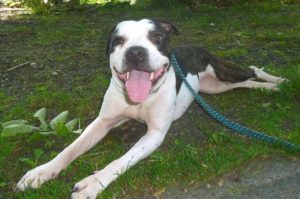
Be-a-Better-Gardener – The Dog Days of Summer
 Landscaping for your dog is easier than you think!
Landscaping for your dog is easier than you think!
By Thomas Christopher
These days, July 3rd through August 11th, are the dog days of summer. This name actually reflects an ancient belief that the hottest days of the year were dictated by the rising of the “Dog Star,” Sirius, but I’m going to take this opportunity to reflect on the landscaping needs of our four-footed companions. Because, with planning, a backyard that hosts a dog doesn’t have to be the usual beaten-down expanse of mud.
I started thinking about this a few years ago when a neighbor asked me to help them resurrect just such a disaster area. We began by noting where the dogs’ (my neighbors had two) customary runways were. For example, when they were let out from the back door, the dogs immediately ran to the back corner of the yard to bark at (and greet) the next-door neighbor’s dog. So we paved this track with wood chips, as we did with the dogs’ other paths. We lined the paths with temporary fencing and then tilled the remaining expanse of mud and replanted it with a mixture of a salt and wear-resistant turf-type tall fescue grass. The need for a wear-resistant grass was obvious; I used a salt-resistant cultivar because it would be less easily damaged by the dogs’ urine. We removed the fencing once the grass was well rooted in, and the yard has remained pleasantly green ever since.
This was an easy fix because my friend’s back yard was relatively spacious and provided lots of room for the dogs’ activities. A smaller lot, where the pressure on each square foot is more intense, would have required more ingenuity. Some of the solutions that have been recommended to me include:
- Surfacing the area along a perimeter fence with mulch or pea gravel. Dogs like to patrol the borders of their territory, and will commonly trample any perimeter plantings. Give them an appropriately surfaced path to avoid such damage.
- I have been warned to avoid the use of cocoa hull mulch where dogs roam.Apparently, cocoa mulch may contain theobromine, the same ingredient that makes chocolate poisonous to dogs.
- Plant in raised beds or mounds. This will encourage the dogs to stay off the planted areas.
- Surround your plantings with barriers of resilient plants such as ornamental grasses or a low hedge of boxwood or dwarf privet. If the dogs blunder into such a barrier, they won’t flatten it, and its mass will help to exclude them from the more delicate specimens inside.
- An attractive, low picket fence will also help to protect plantings from dogs.
- If your dog is a confirmed digger, provide a sandbox to accommodate this activity. Bury bones or other treats in the sand at first to establish the sandbox as a place worth exploring.
- The American Society for the Prevention of Cruelty to Animals offers lists of plants – some are landscaping stand-bys – that are toxic to dogs and cats. You can find these on-line athttps://www.aspca.org/pet-care/animal-poison-control/toxic-and-non-toxic-plants.
- Provide your dog with a continual supply of fresh drinking water. This is essential to their comfort, especially in hot weather, and by keeping the dog hydrated, it will help to dilute their urine, minimizing its effect on lawn areas.
- Finally, be sure to furnish a shady retreat – an arbor or dog house works well. Your companion will need it during these dog days.
Thomas Christopher is the co-author of “Garden Revolution” (Timber Press, 2016) and is a volunteer at Berkshire Botanical Garden. berkshirebotanical.org
Be-a-Better-Gardener is a community service of Berkshire Botanical Garden, one of the nation’s oldest botanical gardens in Stockbridge, MA. Its mission to provide knowledge of gardening and the environment through 25 display gardens and a diverse range of classes informs and inspires thousands of students and visitors on horticultural topics every year. Thomas Christopher is the co-author of Garden Revolution (Timber press, 2016) and is a volunteer at Berkshire Botanical Garden. berkshirebotanical.org.

